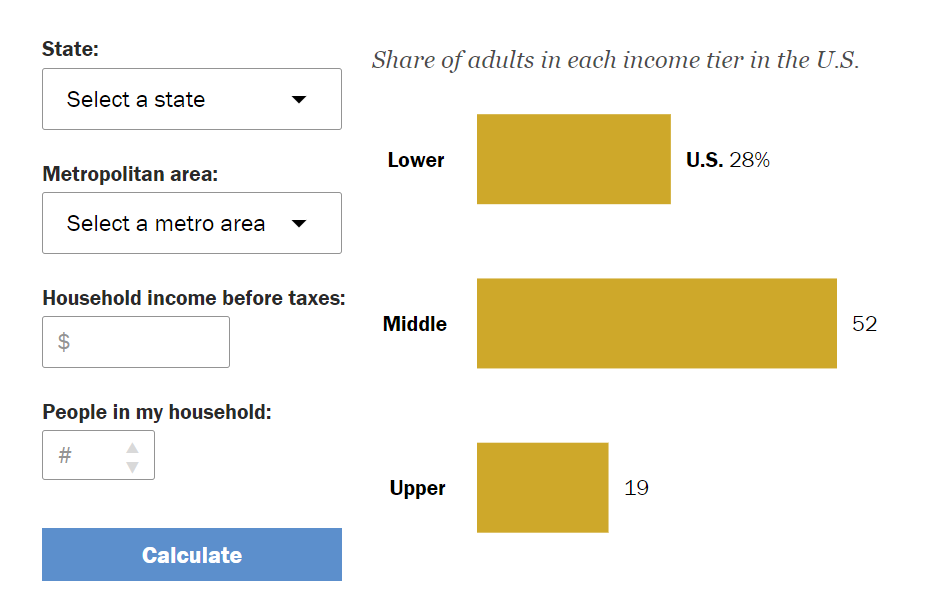Are You Middle Class?
The share of Americans in the middle class has been dwindling for decades. Here's how to tell if you're part of the shrinking middle class.


The share of Americans considered to be middle class is now the smallest it has been in five decades, having steadily contracted since the 1970s. The share of adults who live in middle-class households fell from 61% in 1971 to 50% in 2021, according to the Pew Research Center. Are you part of the “shrinking” middle class? You can use the updated calculator from Pew Research Center to find out.
In 2022, 52% of adults lived in middle-income households, 28% were in lower-income households and 19% were in upper-income households. But this varies widely between cities. For example, 42% of adults in San Jose-Sunnyvale-Santa Clara, California, are considered middle class, compared to 66% in Olympia-Lacey-Tumwater, Washington.
Here’s how to determine whether you're considered middle class and how you compare to the rest of the population.
From just $107.88 $24.99 for Kiplinger Personal Finance
Become a smarter, better informed investor. Subscribe from just $107.88 $24.99, plus get up to 4 Special Issues

Sign up for Kiplinger’s Free Newsletters
Profit and prosper with the best of expert advice on investing, taxes, retirement, personal finance and more - straight to your e-mail.
Profit and prosper with the best of expert advice - straight to your e-mail.
Who is considered to be middle class?
To determine whether or not you’re considered middle class, the calculator from Pew Research Center uses your size-adjusted household income and the cost of living in your area to determine your income tier. Middle-class definitions can vary, but for this calculator, the middle class is defined as households with an income that is two-thirds to double the U.S. median household income.
To use the calculator, you’ll be asked to fill in where you live (including the state and metropolitan area), your total household income before taxes and the number of people in your household. This enables you to see the share of adults in each income tier in your area and the U.S., including which income tier you fall in.
Here's a look at the income calculator, which you can access here.

You’ll also be able to compare yourself to adults similar to you in education, age, race, ethnicity and marital status, if that’s of interest to you.
The calculator takes your household income and adjusts it for the size of your household, which is revised upward for households that are below-average in size and downward for those of above-average size, so each household’s income is made equivalent to the income of a three-person household.
For 2022, middle-class incomes ranged from about $56,600 to $169,800, lower-income households had incomes less than $56,600 and upper-income households had incomes greater than $169,800.
The shrinking middle class
As the share of middle-class households declined, the share of lower- and upper-income households increased. From 1971 to 2023, the share of Americans who lived in lower-income households increased from 27% to 30%, and the share who lived in upper-income households increased from 11% to 19%.
And while household incomes have risen across all income tiers since 1970, the gains for middle- and lower-income households are smaller than gains for upper-income households, creating a larger gap between upper-income households and other households.
The median income of middle-class households increased by 60% between 1970 and 2022, while the median income of upper-income households increased by 78%. The median income of lower-income households grew by only 55%.
Related Content
Profit and prosper with the best of Kiplinger's advice on investing, taxes, retirement, personal finance and much more. Delivered daily. Enter your email in the box and click Sign Me Up.

Erin pairs personal experience with research and is passionate about sharing personal finance advice with others. Previously, she was a freelancer focusing on the credit card side of finance, but has branched out since then to cover other aspects of personal finance. Erin is well-versed in traditional media with reporting, interviewing and research, as well as using graphic design and video and audio storytelling to share with her readers.
-
 Stocks Chop as the Unemployment Rate Jumps: Stock Market Today
Stocks Chop as the Unemployment Rate Jumps: Stock Market TodayNovember job growth was stronger than expected, but sharp losses in October and a rising unemployment rate are worrying market participants.
-
 Should You Renew Your CD?
Should You Renew Your CD?With rate cuts impacting earnings, we examine if now is a wise time to renew CDs.
-
 7 Ways to Plan Now to Save on Medicare IRMAA Surcharges Later
7 Ways to Plan Now to Save on Medicare IRMAA Surcharges LaterUnderstand the critical two-year lookback period and why aggressive planning before you enroll in Medicare is the most effective way to minimize IRMAA.
-
 Should You Renew Your CD?
Should You Renew Your CD?With rate cuts impacting earnings, we examine if now is a wise time to renew CDs.
-
 Where to Store Your Cash in 2026
Where to Store Your Cash in 2026Set yourself up for success with these strategies.
-
 I'm a Financial Adviser: The Fed's Rate Cuts Could Have Impacts You Might Not Anticipate
I'm a Financial Adviser: The Fed's Rate Cuts Could Have Impacts You Might Not AnticipateUnderstanding how lower interest rates could impact your wallet can help you determine the right financial moves to make.
-
 My Teen Crashed His Car, and Now Our Insurance Has Tripled. What Now?
My Teen Crashed His Car, and Now Our Insurance Has Tripled. What Now?Dealing with the costly aftermath of a teen car accident is stressful. Here are your options for navigating it.
-
 My First $1 Million: Retired In-House Corporate Lawyer, 74, Midwest
My First $1 Million: Retired In-House Corporate Lawyer, 74, MidwestEver wonder how someone who's made a million dollars or more did it? Kiplinger's My First $1 Million series uncovers the answers.
-
 I'm an Insurance Pro: Going Without Life Insurance Is Like Driving Without a Seat Belt Because You Don't Plan to Crash
I'm an Insurance Pro: Going Without Life Insurance Is Like Driving Without a Seat Belt Because You Don't Plan to CrashLife insurance is that boring-but-crucial thing you really need to get now so that your family doesn't have to launch a GoFundMe when you're gone.
-
 The Top 22 Gifts for Grandkids from Walmart in 2025
The Top 22 Gifts for Grandkids from Walmart in 2025From PlayStation to Labubu, you'll find the hottest gifts of 2025 for your grandkids at Walmart this year. Some of them are up to 78% off.
-
 CD vs. Money Market: Where to Put Your Year-End Bonus Now
CD vs. Money Market: Where to Put Your Year-End Bonus NowFalling interest rates have savers wondering where to park cash. Here's how much $10,000 earns in today's best CDs versus leading money market accounts.